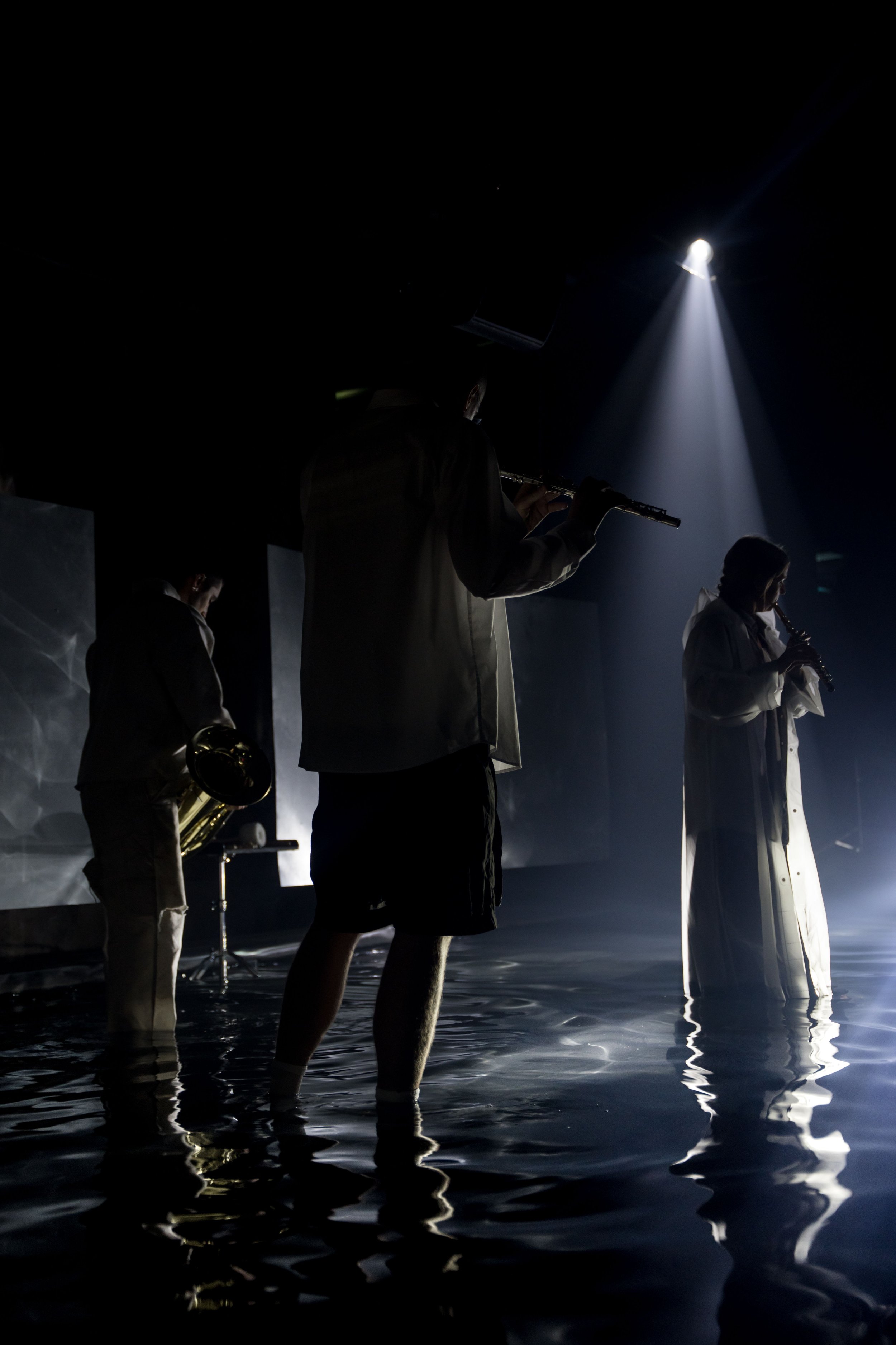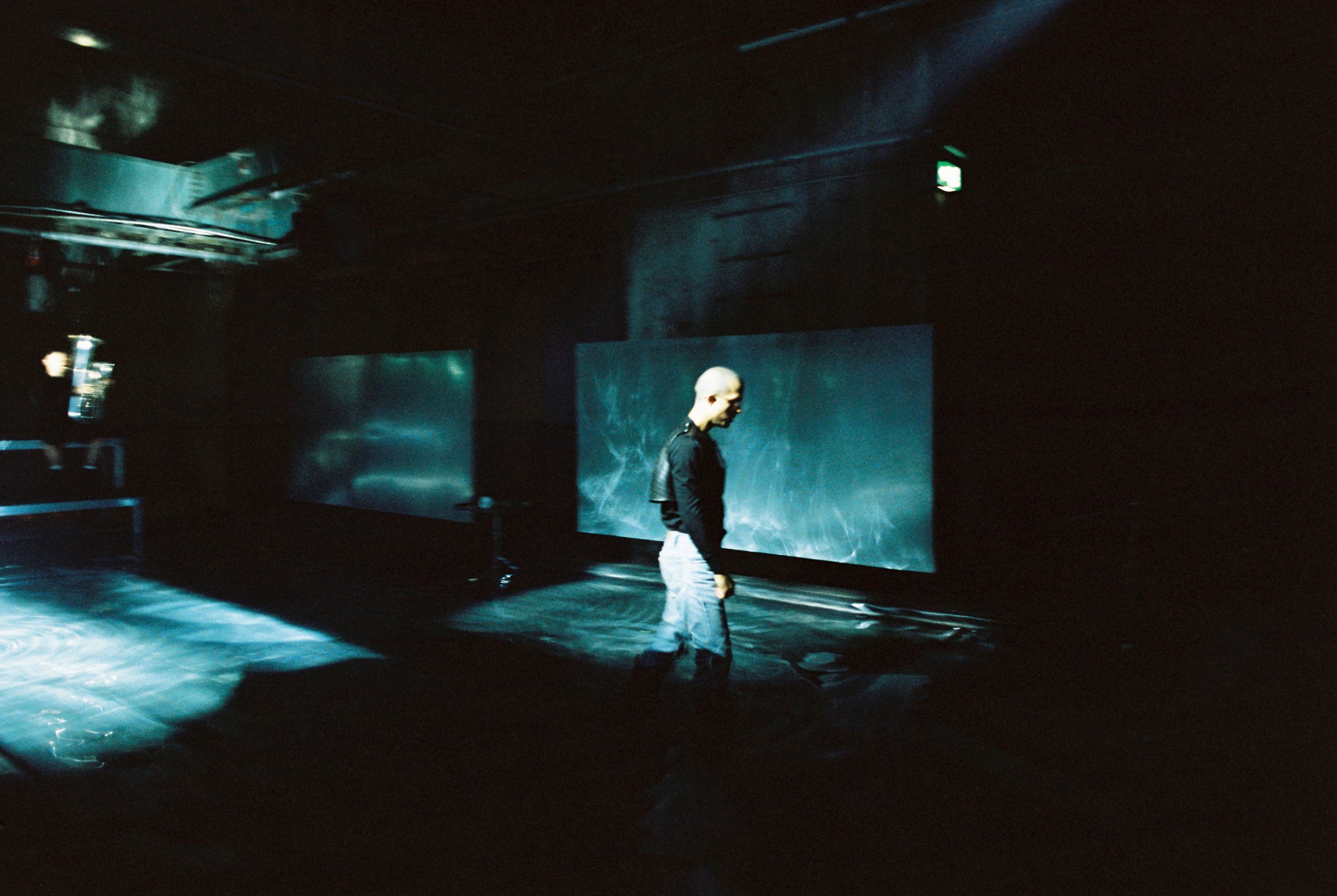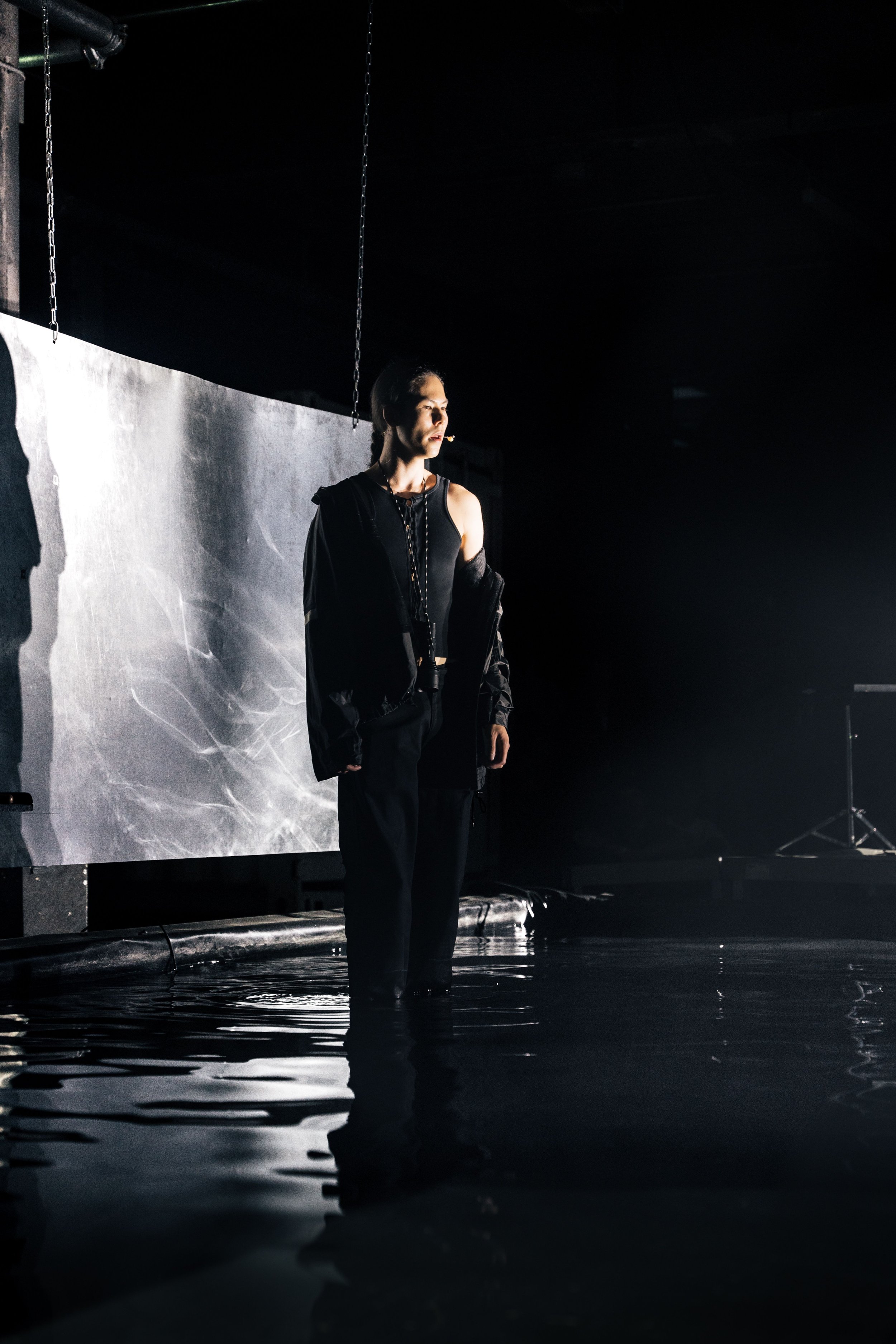Billy Bultheel’s Idea of Ecstasy
Billy Bultheel is a composer and performance artist. His performance pieces are often site-specific, but also context-sensitive. This interview goes back to Berlin Atonal 2023, which took place in one of the world's most unique venues for electronic music and contemporary art, Kraftwerk Berlin.
The colossal former concrete power plant fulfills the role of a true monument, renovated not to commemorate past events but to host new ones. Between the two weekends of Berlin Atonal, there was an extension in the form of an exhibition entitled "Universal Metabolism", consisting of static objects, but also pieces that begin and end. On the fourth night of the exhibition, spotlights illuminate the vast dark halls just for the inevitable movement of visitors, and on the second floor of the Kraftwerk there is a scene with a pool built for Billy Bultheel’s latest collaborative performance "The Thief’s Journal", which he developed together with curator Marie-Therese Bruglacher. Read more about the performance, but also about Billy’s creative journey in the interview and be prepared for his debut solo album "Two Cycles" to be released on March 8th via Berlin's famous interdisciplinary music label PAN. However, this is not Bultheel's first collaboration with PAN. Since 2012, he has been an active collaborator alongside the German visual artist and choreographer Anne Imhof and US artist Eliza Douglas. Together they released music albums "FAUST" in 2019 and "SEX" in 2021, which Billy also talks about in the text.
N: Once you described your music to be something, which happens in between a techno club and a church. I think this characterizes your composition and production very well. But why did you choose music and sound to be your primary medium in the first place?
B: I have always been drawn to music and started engaging with it at a very young age. What I’m trying to do is bring music and an idea of performance together to create a more intimate relationship towards the music. Take music out of its abstract realm where people mostly place it. You can just close your eyes and enjoy the music, but I really want people to use their eyes and their other senses to understand that music exists within a context. It could be a spatial context, a social context, or a choreographic context. I use that as a part of my compositional methods. I studied music and composition and after that, I went into dance, theatre, and choreography pretty much because I wanted to make music more visceral.
N: You are not only a musician. Your work as a complex artist with a strong connection to contemporary art. I have read a paper where you talked about a sound sculpture. Art theory is used to describe it as a physical object which generates sound. However, I always thought that sound sculpture could be also just a sound in a space by itself. What does this term mean to you?
B: Music is a physical phenomenon that happens when two objects meet, so there is always this physical element to it. I also want to bring up the relationship between the object and the person.The metal plates (at the performance at Atonal) and the way that the drummers interact with them, you could see it as a dance or as a kind of a physical encounter between the drummer and that instrument. Most of the time musicians kind of disappear behind their instruments and you don't really see them as people. I think that I bring this physical element to the front, in the way. Also, the musicians themselves, they become much more connected to the characters within the soundscape or within the music that they play. It brings this very human element to music.
N: Do the particular instruments in your performances appear purely as tools for creating a sound, or can they become the object themself? Do you sometimes use an instrument because of its aesthetic value?
B: They become a scenography the way how everything is architecturally distributed in the space. It is meant to create trajectories through the space and to create an environment where the audience embeds themselves more. I feel like it's a little bit similar to the experience of entering the church. You immediately become very calm, because you sense the acoustics in the space are different. One of the architectural aspects in a space is that all the objects become part of the story. That's why I also like the trajectories between these different objects and between all these different locations within the scenography. It allows the musicians to travel within the audience, within that architecture, which is surrounded by the musicians, surrounded by the music.
N: The performance for Atonal 2023 happened in Kraftwerk Berlin which is a very rough, dark, post-industrial building. But in that space you created a pool, which seemed on the other hand very soft to me. The whole performance and the water itself remained as something tender in an utter wide space.
B: I think the water is kind of important. The sounds travel over the water in a specific way and the water then moves together with the sound. However, the way that performers walk through the water, or the way that the water slows down your pace and makes the whole movement more musical is way more important. So, the water significantly contributed to the music itself, creating a different type of musical pace through the walking, playing, and perceiving. It's just like a weird physical/visual addition to that architecture which makes everything somehow newer and more musical.
N: What made you choose a specific instrument for this performance?
B: I combined a couple of previous existing performances into one larger structure. In this case, it was two different ensembles that were brought together. The first ensemble were the four tuba players in the counter. I put it together with the idea of prosthetic voices, where there's no longer a trained singer that comes from a tradition of castrati, which links the tuba and the counter tenor. I always think of brass instruments as kind of extensions of the vocal cords. The way you play brass is you vibrate it, so it's a very vocal instrument. The other ensemble was percussion and flute, which was already made for an abandoned swimming pool with water in it. I knew that these performances were going to engage with water, so I wanted to have an ensemble that could do both.
N: In your pieces, there are performers, actors, and other artists involved. Are your collaborators always comfortable with a role of a musician, but at the same time a performer/actor?
B: Yeah, it's fun because musicians are not used to being on stage in the same way as performers are. Normally they kind of disappear behind their instruments. My entire mission is to bring forward the musicians as characters in the landscape and have them play music through them. I think in this case they fully became the world that this piece was trying to create. You would think there's stage fright but there's also stage joy that they happily embrace, they always surprise me. Musicians are such funny people, they’re interesting to look at.
N: I want to ask you about the movement of performers on the stage. Is it hard to perform music and adhere to the choreography at the same time for them?
B: We don't speak so much about the movement, I am giving them some directions, but what they rehearse the most is playing the pieces of music. Then we just discuss trajectories, but in some way, they always end up being kind of under their own spell and playing, it's nice. They become a little bit hypnotized by their own music.
N: Can you imagine performing this piece elsewhere, or was it designed as a site-specific work for Kraftwerk?
B: It was designed for Kraftwerk, but I could imagine doing the piece again. I work with an architect and scenographer Andrea Belosi and an amazing curator Marie-Therese Bruglacher. With the help of these people I think we can definitely imagine setting that piece in different spaces.
N: You dropped an album together with 33. What is interesting to me is that you called that project a band. What was your intention behind starting a band?
B: Me and Alex (Alexander Iezzi), we have been friends for a long time and he's also been performing in my works many times. I think it was one of those Covid lockdown moments, when we were like “let's have some fun”. We didn't just want to make some bangers and techno but also experiment more with this idea of pop music. With the band, It keeps the spirit young though. And it's fun to tour with the band. You fly and you play a gig and then you fly out together. I really enjoy it. I think it's nice to be a little bit on different levels also.
N: The album consists techno bangers, but it also becomes very dramatic. You collaborated with Steve Katona on the album, so there are castrate voices and some ambient tracks too. What's this duality between the mentioned church and the techno club or between the specific genres in your work?
B: I guess it's the two places where I get my influences from. Over the years of making these kinds of larger pieces, you gather a group of musicians around you, and everyone becomes close friends. I feel very lucky that all these people are also very experimental and open minded. I think it's inevitable that there's a crossover between these band projects and let's say larger pieces. Maybe the cross over between techno and church music is the idea of ecstasy or having these cathartic moments with music. I feel like with 33, when we started, we said that we only want to do two different types of shows – either it's a performance or it's a DJ gig, a dance floor music. We wanted the audience to feel engaged. Either truly dancing to it or having some kind of dramatic involvement.
N: I would like to go back to your collaboration with Anne Imhof on Faust, Angst and Sex. Was this experience inspirational also for your own performances?
B: Yeah, of course, working with Anne has shaped the work intensely. I've worked with Anne since she graduated from art school. I think a lot of the material or strategies were very much developed in collaboration. I learned a lot from her, and I think she also learned a lot from me in that sense. Especially entering these big spaces and these bigger institutions like the German pavilion at Venice Biennale or the Hamburger Bahnhof. It makes you understand more and more of how architecture and music interconnect with one another and how they can become a space. I think Anne is someone with an immense amount of courage and she goes for things. The biggest inspiration to take from her is not to be afraid to go big or really embed an entire world somehow. When you're sitting and you're making a piece of music, it comes out of two small speakers, and you listen to it. Being able to think about that piece of music as something that takes over an entire space with 1000 people in it is a very difficult step. It's not a natural progression. I feel like that was quite an important lesson for me – to be able to speculate. I gained insights into how the actions you're taking on a small scale can translate into a much larger impact through my collaboration with Anna.
Interview: Niki Bernath ©New Translation 2024








